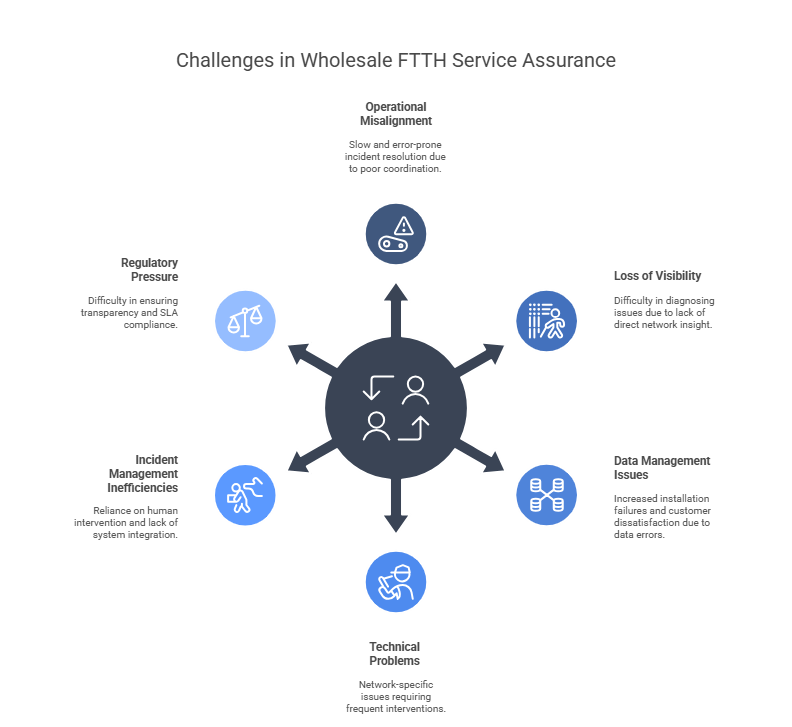From shared chaos to total control: Service Assurance challenges in complex FTTH networks

Introduction
The telecommunications sector is undergoing profound transformation. Fiber to the Home (FTTH) isn’t merely a technological upgrade; it’s an enabler of new business models and a critical battleground for customer experience. However, the shift from vertically integrated models to wholesale ecosystems, where network services are assets, has introduced new operational complexities. This new paradigm, characterized by operation owners delivering the services, poses enormous challenges for Service Assurance (SA). Transitioning from initial ‘shared chaos’ to effective ‘total control’ is the main challenge to ensure profitability and customer satisfaction in today’s competitive FTTH market.
1. The starting point: traditional vertical model
Historically, telecom operators controlled the entire value chain: physical infrastructure, network equipment, offered services, and direct customer relationships. This vertically integrated model allowed centralized management and complete end-to-end data visibility. Consequently, Service Assurance was comparatively simpler, with a single accountable entity enabling rapid diagnosis and efficient incident resolution. However, this monolithic approach limited competition, innovation, and efficiency by depending entirely on one provider.
2. Evolution towards Wholesale: separation of roles, added complexity
Increasing demand for high-speed connectivity and regulatory pushes have driven the evolution toward wholesale models, particularly in FTTH networks. In this structure, network service providers (NetCo) and Internet Service Providers (ISPs) are separate entities. This separation allows multiple ISPs to compete over the same infrastructure, theoretically fostering efficiency and innovation.
Nevertheless, role separation introduces additional data management complexity, particularly affecting Service Assurance. Gartner highlights the importance of regulatory frameworks ensuring NetCo independence and equitable access, but operational management inevitably becomes fragmented.
3. New Service Assurance challenges in Wholesale FTTH
The fragmentation of responsibilities between NetCos and ISPs creates specific and significant Service Assurance challenges, directly affecting perceived quality and operational efficiency:
Operational fragmentation and misalignment: Role separation and data access complicates coordination. Identifying root causes and assigning responsibilities during incidents often becomes slow and error-prone, with tickets bouncing between NetCo and ISP, increasing Mean Time To Repair (MTTR). TM Forum studies indicate up to 68% of users attribute recurrent failures to poor coordination.
Loss of end-to-end visibility: ISPs, managing customer relationships, frequently lose direct visibility into the real state of underlying network service. They rely on information from NetCo—often partial or delayed—complicating precise and rapid problem diagnosis affecting customers.
Fragmented data and process management: Lack of precise, standardized data on infrastructure (port status, OLTs, ONTs, topology) and complexity in service activation processes (errors in GPON port assignments, incorrect addresses) increase installation failure rates and immediate customer dissatisfaction. API standardization (promoted by TM Forum) is vital but adoption and correct implementation remain challenging.
Technical problems inherent to FTTH: Network-specific technical issues compound model complexity: attenuation due to poor installations (macro/micro bends), defective splices, connector dirt, accidental cuts, or incorrect client device configurations (reset ONTs) requiring interventions.
Incident management inefficiencies: Despite advances, sector analyses (e.g., Comarch) show up to 70% of multi-operator network operations still depend on human intervention. Lack of integration between legacy systems and modern tools impedes alarm correlation to actual service/customer impacts, essential for efficient root-cause analysis.
Regulatory pressure and SLA compliance: Models like D-FTTH demand transparency in physical resource allocation, and strict Service Level Agreement (SLA) adherence becomes harder to measure and ensure in multi-technology, multi-stakeholder environments.

4. Critical impact: customer experience and operational efficiency
Wholesale FTTH complexity directly impacts two critical areas if not properly managed:
Customer Experience (CX): Longer resolution times, multiple customer interactions, failed installations, and generally poor service perception directly result from fragmentation and visibility issues. This erodes trust, increasing churn probability.
Operational Efficiency (OpEx): Manual processes, unnecessary technical visits, inefficient incident resolutions, and SLA non-compliance penalties significantly inflate operating costs. FTTH Council Europe data suggests up to 40% of operational budgets may go to resolving avoidable incidents.
5. Linking Strategy and Operation: ICTQ Framework
These operational challenges transcend technical issues, impacting strategy directly, analyzed through the ICTQ (Income, Cost, Time-to-Market, Quality) framework:
Income: Poor customer experience due to deficient SA leads directly to revenue loss from churn. Conversely, robust, proactive SA improves retention and enables premium service offerings with superior guarantees.
Cost: SA inefficiencies (manual processes, incorrect diagnoses, repeated visits) directly inflate OpEx. Automating and optimizing SA processes are key levers to cost reduction.
Time-to-Market: Although SA primarily addresses post-sale issues, efficiency in provisioning and activation (relying on precise data and integrated processes) is crucial for the rapid launch of new services or onboarding new ISPs. Efficient SA ensures reliability from launch.
Quality: Central to Service Assurance, perceived customer quality intrinsically depends on network reliability, rapid problem resolution, and proactive communication-all managed by SA functions. High quality reduces churn and strengthens branding.
6. Path to Control: Automation, Integration, Intelligence
Overcoming Service Assurance challenges in complex FTTH networks demands transformation towards unified, intelligent, and automated systems. Key trends include:
Process Automation: Especific wholesale-designed processes and advanced service management employ AI for incident prioritization, automated diagnostics, significantly reducing MTTR (by up to 60%, per studies).
System Integration via Standardized APIs: Adoption of standardized APIs (notably TM Forum’s) ensures seamless communication between NetCo and ISP systems, breaking down information silos.
Advanced Monitoring and Visibility: Tools offering proactive monitoring, predictive analytics (anticipating splitter failures or signal degradation based on historical data and real-time telemetry), and shared visibility are essential.
Centralized Service Assurance Platforms: Solutions integrating monitoring, analytics, ticket management, and automated workflows (such as the mentioned BSAP) provide necessary control in complex environments. Experiences in the Spanish market with various operators (major incumbents to pure wholesalers) demonstrate feasibility and benefits of these implementations, often using adaptable tools like Atlassian Jira as a core for incident management and integration.
Auto-Configuration Servers (ACS): Solutions remotely reconfigure ONTs, preventing unnecessary, costly technical visits.
Our Takes: from Complexity to Opportunity
Transitioning to Wholesale FTTH models has undoubtedly introduced complexity to Service Assurance. Initial ‘shared chaos,’ stemming from fragmented roles and systems, must give way to ‘total control’ through intelligence, automation, and collaboration. Embracing strategic approaches aligned with ICTQ pillars and leveraging advanced technological platforms and open standards is not optional but essential for operators aiming to thrive. Only through this can optimal customer experience, operational efficiency, and business sustainability be assured in today’s dynamic, demanding digital ecosystem. Automation, integration, and artificial intelligence are clearly key to navigating complexity, transforming challenges into opportunities.



